
by Chris Mah, Smithsonian Institution, National Museum of Natural History
April 29, 2018
As one of the most heavily studied areas in American waters, I expected that most NOAA Ship Okeanos Explorer observations in the Gulf of Mexico would likely be species of sea stars that were reasonably well known—or at least familiar.
I was delighted to be wrong! As Okeanos Explorer surveyed these deeper and unexplored regions, I was reminded that the Gulf of Mexico is a potential treasure trove of unknown, distinctive, and fascinating echinoderm species!
Below are five Okeanos Explorer observations that I’ve found particularly interesting during our past week of exploring deep-sea habitats of the Gulf of Mexico!
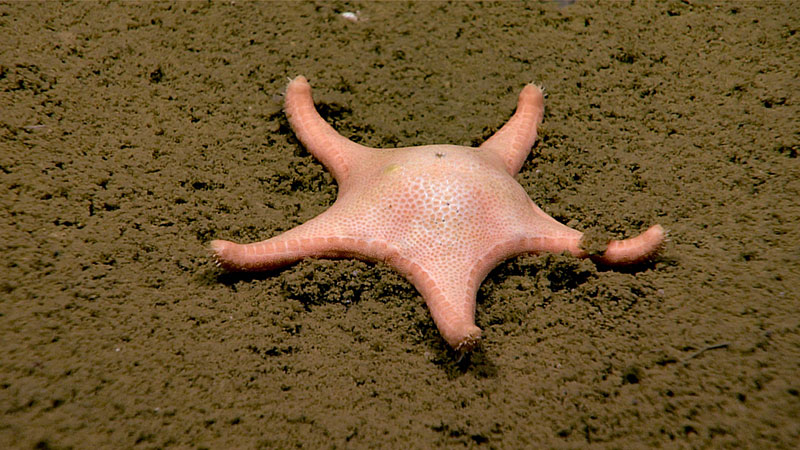
Image courtesy of the NOAA Office of Ocean Exploration and Research, Gulf of Mexico 2018. Download larger version (jpg, 1.0 MB).
One of the ongoing mysteries that marine biologists have dealt with since they started sampling the deep sea has been the realization that some species that look very similar to one another can occur widely—sometimes in one, two, or even all of the world’s ocean basins.
One species, which I only recently described in 2015, was known primarily from the Pacific and off the Atlantic coast of Africa. The Okeanos Explorer has now observed this species, called Sibogaster nieseni, from the Gulf of Mexico!
This further adds to the mystery of this potentially widespread, deep-sea sea star. How widely does it occur? How do these individuals become so widely distributed? What makes the deep sea such an ideal habitat for these species? Its presence here also suggests a close relationship with the similar Circeaster americanus. And more importantly, how many other species of sea stars are found all over the world? So many questions!
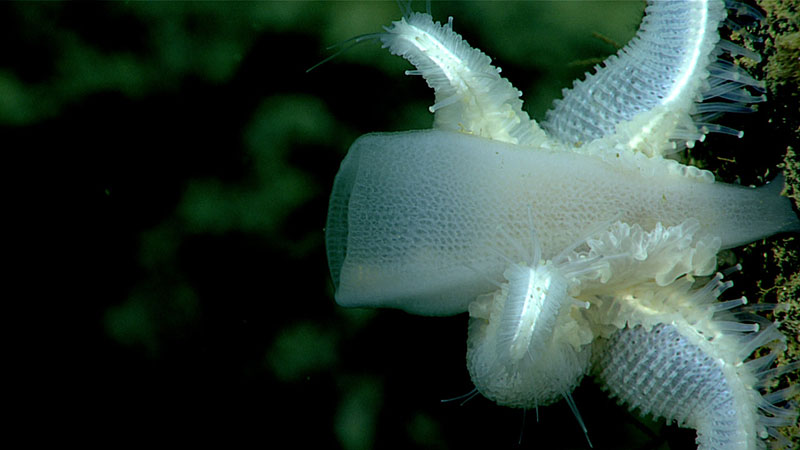
Image courtesy of the NOAA Office of Ocean Exploration and Research, Gulf of Mexico 2018. Download larger version (jpg, 765 KB).
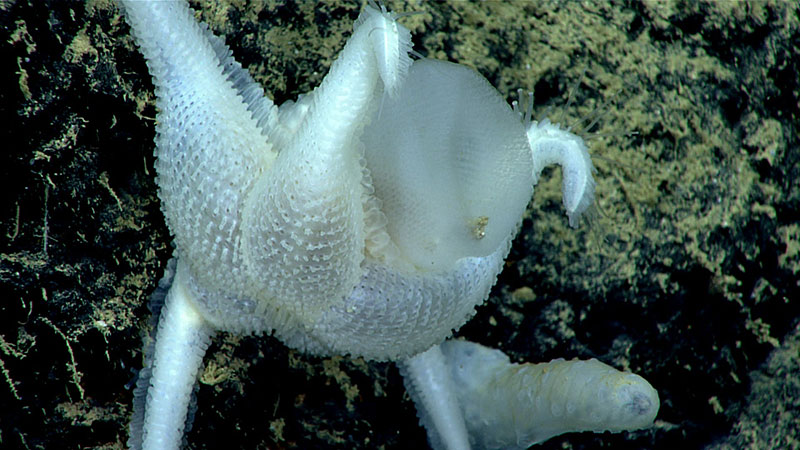
Image courtesy of the NOAA Office of Ocean Exploration and Research, Gulf of Mexico 2018. Download map (jpg, 1.1 MB).
Pythonaster is an unusual and rarely seen sea star in the family Myxasteridae, with long arms and a translucent body surface, layered with a thick membrane and having spines in ordered rows that are each covered by a thick skin. It was first collected and described by the Challenger Expedition in 1889. Since then, it had been known globally from eight specimens.
Until the Okeanos Explorer Northeast U.S. Canyons Expedition in 2013, Pythonaster had never been seen alive! Science had only known these animals from preserved specimens collected by trawl nets. We had no idea of its biology and ecology—much less its feeding biology, or even its natural color when alive!
Last week, Okeanos Explorer recorded a Pythonaster species feeding on a glass sponge for the very first time, thereby providing important insights into the biology of this sea star!
There had been ambiguous images of Pacific Pythonaster perched on deep-sea glass sponges, but this observation was beautiful in both its clarity and its scientific value.
The ruffled soft tissue wrapped around the sponge is the star’s pyloric stomach, which is extended onto the prey and is feeding on the tissue of the glass sponge—making this very strong evidence of the feeding behavior for this very rarely seen species.
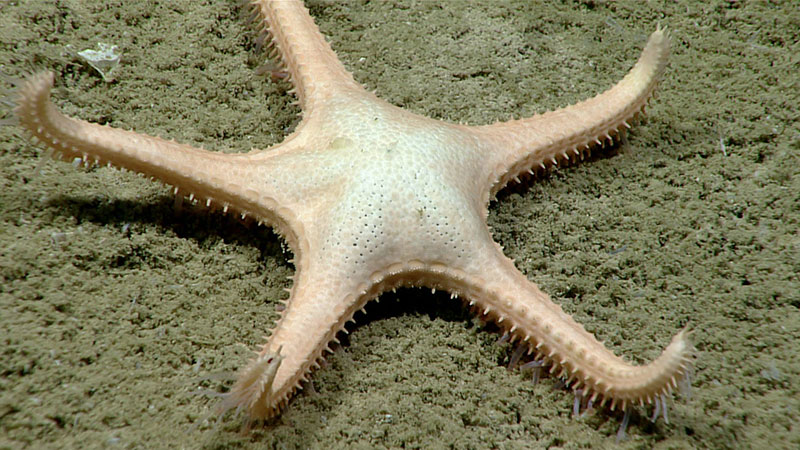
Image courtesy of the NOAA Office of Ocean Exploration and Research, Gulf of Mexico 2017. Download larger version (jpg, 1.3 MB).
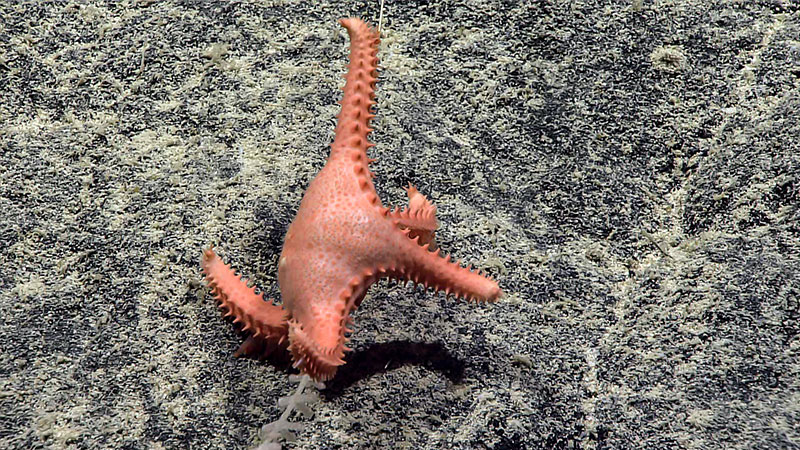
Image courtesy of the NOAA Office of Ocean Exploration and Research, Gulf of Mexico 2018. Download map (jpg, 2.5 MB).
What is so interesting about the Gulf of Mexico is that, although it is a relatively well-studied area, so far there have been many remarkable new records—potentially new records or species previously unknown to science! But sometimes what’s even more surprising is where it’s found!
This spiny, coral-eating species was first identified after a specimen was collected during the 2017 Okeanos Explorer expedition to the North Pacific, Deep-Sea Symphony: Exploring the Musicians Seamounts.
Surprisingly, several more individuals of what appear to be the same species were observed and eventually collected from the Gulf of Mexico. Will they turn out to be the same species? Even if they are not exactly the same, they are very similar. Are they related? How did two such similar species evolve in such separate and distant locales from one another?
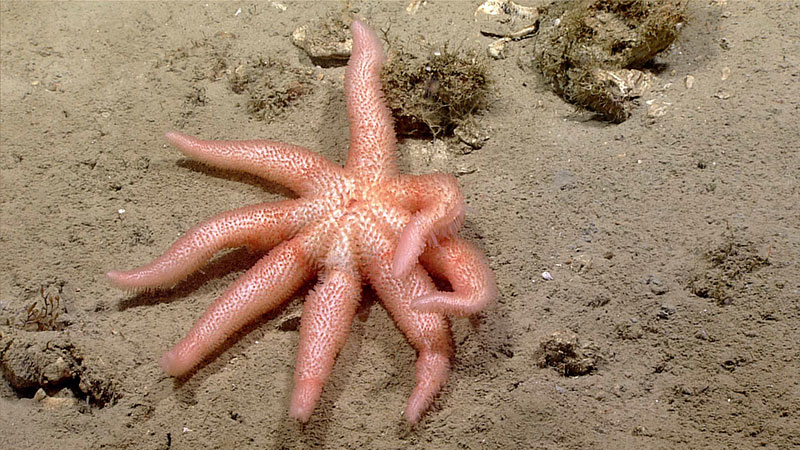
Image courtesy of the NOAA Office of Ocean Exploration and Research, Gulf of Mexico 2018. Download larger version (jpg, 1.5 MB).
As mentioned earlier, sea stars in the family Myxasteridae are just about as strange and esoteric as sea stars can get. They are rarely seen, almost always occur in the abyss, and for sea stars, are very strange looking with a soft, membranous skin and are thought to be present in the Jurassic as fossils! Recent molecular work has shown them to be among some of the earliest members of modern sea stars!
But none have been recorded from the Gulf of Mexico—until the 2018 expedition by the Okeanos Explorer! A multi-armed sea star in this family was observed for the first time in Hidalgo Basin, from approximately 1,047 meters (~3,435 feet). Based only on the imagery, it is significantly different from the known Myxaster sol collected in the North Atlantic (and seen by Okeanos Explorer in 2013) and much larger!
Intriguingly, this species actually resembles a Pacific myxasterid in the genus Asthenactis, which we observed on several occasions in the Pacific during the CAPSTONE campaign.

Image courtesy of the NOAA Office of Ocean Exploration and Research, Gulf of Mexico 2018. Download larger version (jpg, 1.5 MB).
One of the most frequently encountered groups of sea stars around the world, and especially in the deep sea, is called the Paxillosida—more commonly known as the sand or mud stars.
Examples of the life mode of these sea stars can be seen here: http://echinoblog.blogspot.com/2010/03/mystery-of-mud-star-ctenodiscus-revealed.html and here: http://echinoblog.blogspot.com/2013/12/sand-angels-astropectnen-starfish-that.html .
Basically, these species lie buried in the subsurface of mud or sand, such as this one in the genus Dytaster. They sit and swallow massive quantities of the mud around them and slowly digest the food within—sometimes swallowing clams or snails, other times just the organic materials in the mud. Often times these can only be seen by the star-shaped burrows left in the sediment where they are buried.
Watch video of the deep-sea mud star, Dytaster insignis, seen moving over the seafloor during Dive 10 of the Gulf of Mexico 2018 expedition.